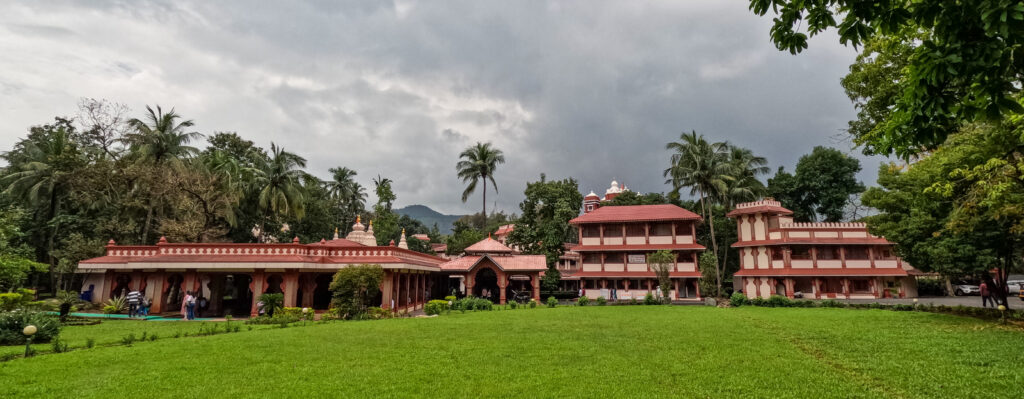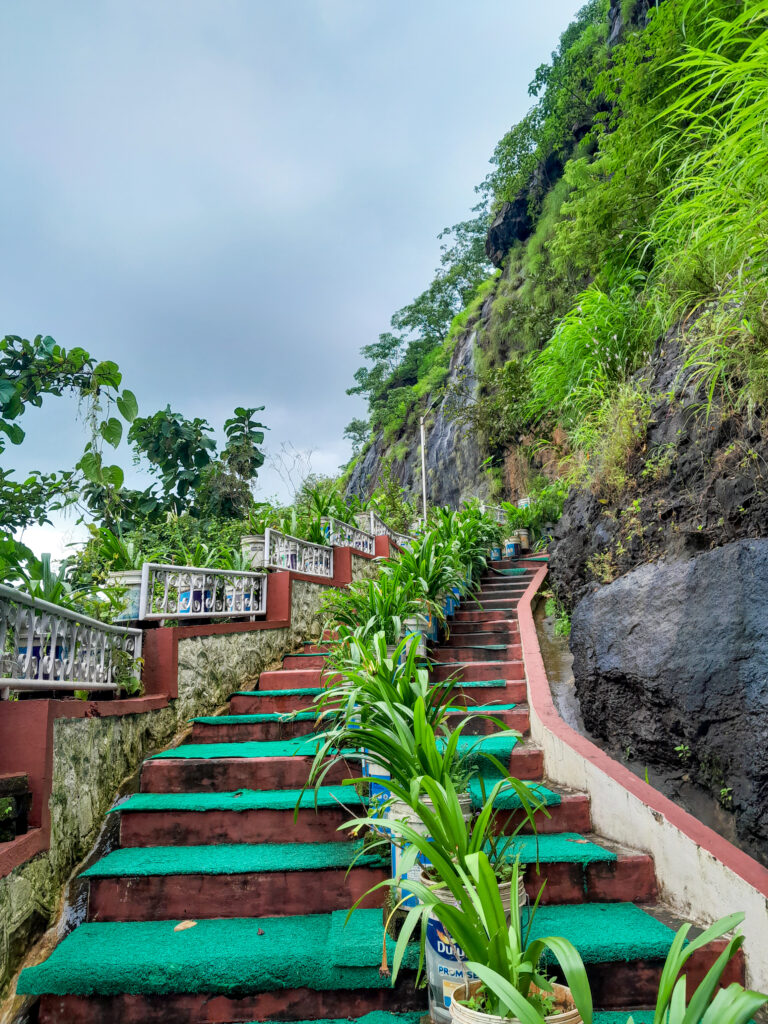There are times when we are uncertain where to travel. Or sometimes we do not get sufficient time to decide due to our frenetic week at the office. In a moment like these, we simply pack our bags and leave our homes in quest of a new place. For us, travel is not always about visiting a planned destination, but also about stepping out unplanned and letting the journey itself open the new vistas. Every experience matters in the world of travel, doesn’t it?
Last Sunday morning, we met at Dadar station and took the second train to Khopoli – the last railway station of central railways. The suburban railway line from Mumbai ends here. We prepared ourselves to roam the roads of Khopoli by enquiring with the locals. Today google has all the answers like things to do in a particular place, places to visit, where and what to eat, etc.. but talking to the locals and finding out about their town is the best experience a search engine cannot give. And sometimes they have stories to tell that cannot be found anywhere else.

We reached Khopoli at 10 am and had a pleasant breakfast in a small south indian hotel called ‘Chutney Sambar’ located on the corner of M G road opposite the Jain temple. The food was simple, delicious and good on the pocket.
Khopoli is an industrial town in Raigad district attracting migrants from across India. During the monsoons, it turns into a city of waterfalls as it is situated at the base of the Sahyadri mountains, surrounded by hills on all sides. Numerous waterfalls cascade down the hills and merge with the Patalganga river. Unlike the Karjat area, Khopoli remains relatively untouched by farmhouse culture. The paddy fields in the monsoon contrast with the scrubs and deciduous forest that provides ample trekking routes to the hills.


We decided to visit one of the villages at the base of the hills.
VIHARI THAKURWADI VILLAGE
This is a small adivasi village and the base point to start the trek to Zenith waterfall and further ahead to KP waterfall. During the peak monsoon, both the waterfalls are not easily accessible. It is advisable to go when the rain subsides. To reach Zenith waterfall, one has to cross a stream and pass through thick bushes. At this time of the month, the waterfalls are not in full strength but nevertheless they still make for a mesmerizing view.



On the way we encountered a huge and impressive multifaceted structural architecture – the ashram complex of the most revered saint Shri. Gagangiri Maharaj.
I had heard lots of real life stories of Gagangiri Maharaj from my father-in-law who is a true devotee of him. He had visited him many times when Maharaj had made an abode on a hill in Gaganbawda in Kolhapur.
A peaceful vibe surrounded the complex and instinctively, without any thought, we entered the holy shrine.
SHRI. GAGANGIRI MAHARAJ ASHRAM
Shri Gagangiri Maharaj, born in Mandure village (Patan) in Satara district of Maharashtra was a Mahayogi and a Hindu Sanyasi (sage) whose teachings are simple yet profound based on his long years of rigorous penance and direct personal experiences and not based on any scriptures. He is particularly known for his water penance and intense meditation practices. His teachings emphasized on living in a harmonious relationship with nature and preserving it. He has many followers across India.
The continuous penances helped him to achieve a considerable amount of self-realization, which was of immense benefit for him. This resulted in a great spiritual merit as people benefited from his meditation techniques, they started worshipping and respecting him.

Gagangiri Ashram is situated in the lap of mountains surrounded by Patalganga river which flows continuously between the temple and enhances the experience. The soothing sound of the flowing river along with keertans and bhajans offers a haven for relaxation. The surrounding natural beauty adds to the peacefulness of the environment.

We washed our hands and feet and moved towards the hall. A photograph of Gagangiri Maharaj was kept on his favourite swing (jhoola) where devotees paid their respects. Three men sat on the floor and enlivened the ambience with their bhajans played using the harmonium, dholak (hand drum) and manjira (pair of small hand cymbals). We sat on the parapet and watched the river flow. The sound of the river and the devotional hymns created an aura of tranquility.
The ashram complex hosts a number of buildings including a hospital, accomodations, meditation center (dhyan kendra), a biogas plant (gaushala), Prati Kedarnath temple and a cave (guha) on a hill where Maharaj used to do penance (tapasya).





The cave is a 15 minute uphill climb from Gaushala. It is carved on a hill giving a beautiful view of the landscape. During the monsoon, the water falls down from the top of the cave and gushes downhill to form a waterfall. An idol of Maharaj in a meditation posture is kept inside the cave.
As we entered, we saw a young couple sitting in ‘dhyana mudra’ in front of the idol. We too sat besides them for some time soaking in the sheer serenity of the place. It really felt peaceful. A priest (pundit) manages the affairs of the cave and sees to it that people maintain silence. The cave in itself is a peaceful place and an abode of Gagangiri Maharaj.


Gagangiri Maharaj has ashrams built across at Dajipur forest (where he commenced his penance in 1932 at the age of 21 after coming from the Himalayas), Gaganbawda in Kolhapur (which he made his abode in 1940 and that’s how he got the name Gagangiri), Ambolgad in Rajapur (where he practiced penances), Manori in Mumbai (where he created an ashram in 1994).
It is at this ashram in Khopoli that Maharaj took MAHASAMADHI on 4th February, 2008. He was 101 years old.

There is a small stall at the entrance to promote home grown products like ayurvedic medicines & soaps, a book library and a counter for the authentic ghee prasad ladoo.
Mahaprasad (lunch) is available between 1:00 pm to 2:00 pm at a nominal cost of Rs 20/-. Food coupons are only available in the time period of 12:00 pm to 1:00 pm. Food is served in the dining hall on steel plates. You are supposed to wash your own plates properly and handover the same. It is a good environment friendly process and also teaches you to be grounded.
The ashram provides a range of spiritual activities and programs, including yoga and meditation. The ashram is a great place to connect with like-minded individuals and deepen your spiritual practice.
It does not matter whether you are a religious person or not, the time spent in the ashram is worth it. Drop all your learnings and pay a visit to this beautiful abode for some peaceful time. The ashram fosters a sense of peace and spiritual growth.
Few things you should know before visiting the ashram:
- There is a counter to keep footwear at the entrance.
- Proper dressing is expected from devotees. No revealing clothes.
- Washrooms are clean and well maintained
- Photography is prohibited inside the temple
- Weekends can be crowded. Reach early to avoid the queue
- No parking available inside the premises.
- Cave timings: 8 am to 1 pm
VIRESHWAR TEMPLE

Just a few metres away from Gagangiri Ashram, built in the 18th century by the Maratha ruler Nana Phadnavis, the Vireshwar Temple is one of the oldest attractions of the region. The temple is made of blocks of black rock and the shikhara (temple top) is conical in nature with a stepped pyramid.

Lord Vireshwar is the incarnation of Lord Mahadeva, who is placed inside the main Garbhagriha (sanctum) of this shrine.
Beside the temple there is a water reservoir which is considered as a holy tank of the Khopoli region. This tank is always filled with clear water and devotees visit year round to take a holy dip in this water. The surrounding walls of the tank are also built in stone which keeps the water cool.


Overall, Gagangiri Maharaj Ashram in Khopoli is a wonderful retreat center that offers a peaceful and enriching experience to guests. Whether you are seeking a break from the chaos of daily life or looking to deepen your spiritual practice, the ashram is a great place to visit.





Thanks for sharing your experience. This place looks amazing. I did like to visit and have a few questions:-
1. Is it alright to travel there alone.
2. What is the frequency of trains from Dadar to Khopoli.
3. How far is the ashram from Khopoli railway station.
4. How does one commute from Khopoli station to the ashram.
Am happy to pick up the phone to have a conversation, please.
Looking forward to hearing from you.
Thanks,
Reema
Hi Reema,
Sorry if I am late to answer this. Yes indeed, the ashram is a beautiful place. Would love to hear your experience if you have visited it.
1. It is safe to travel solo to the ashram. But would not recommend going alone to KP and Zenith waterfall area.
2. The frequency of trains going to Khopoli is less. There are only 9 trains between Dadar and Khopoli in a day. The first morning train leaves at 04:48 am and the next at 07:43 am from Dadar. For a day outing, one has to catch one of these 2 trains. From Khopoli to Dadar return, the train timings in the evening are 04:30 pm and 06:02 pm.
3. The ashram is just 15-20 minutes walk from the station.
4. You can either walk it out or autos are available.